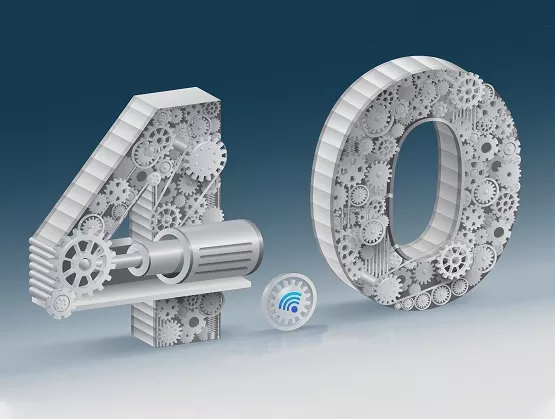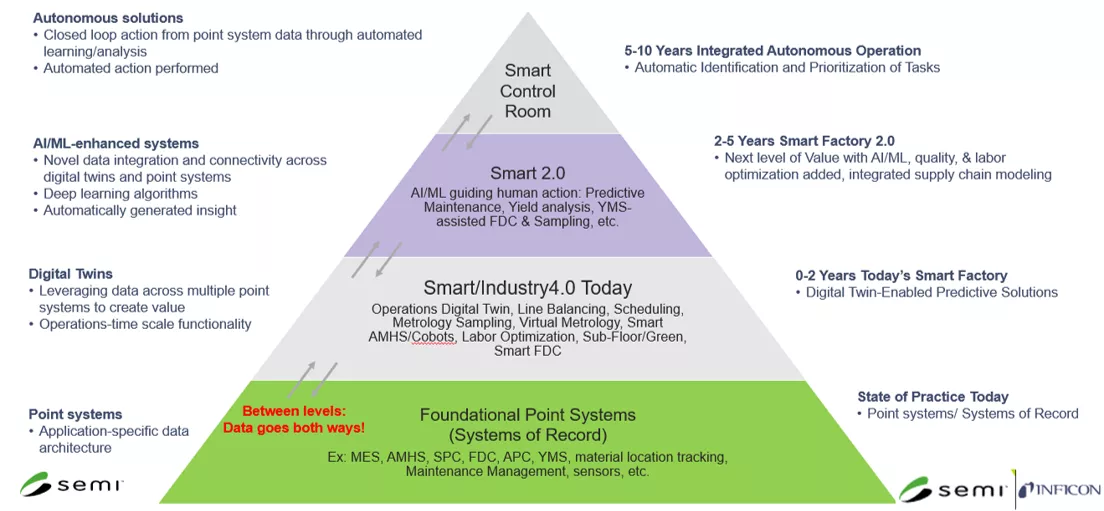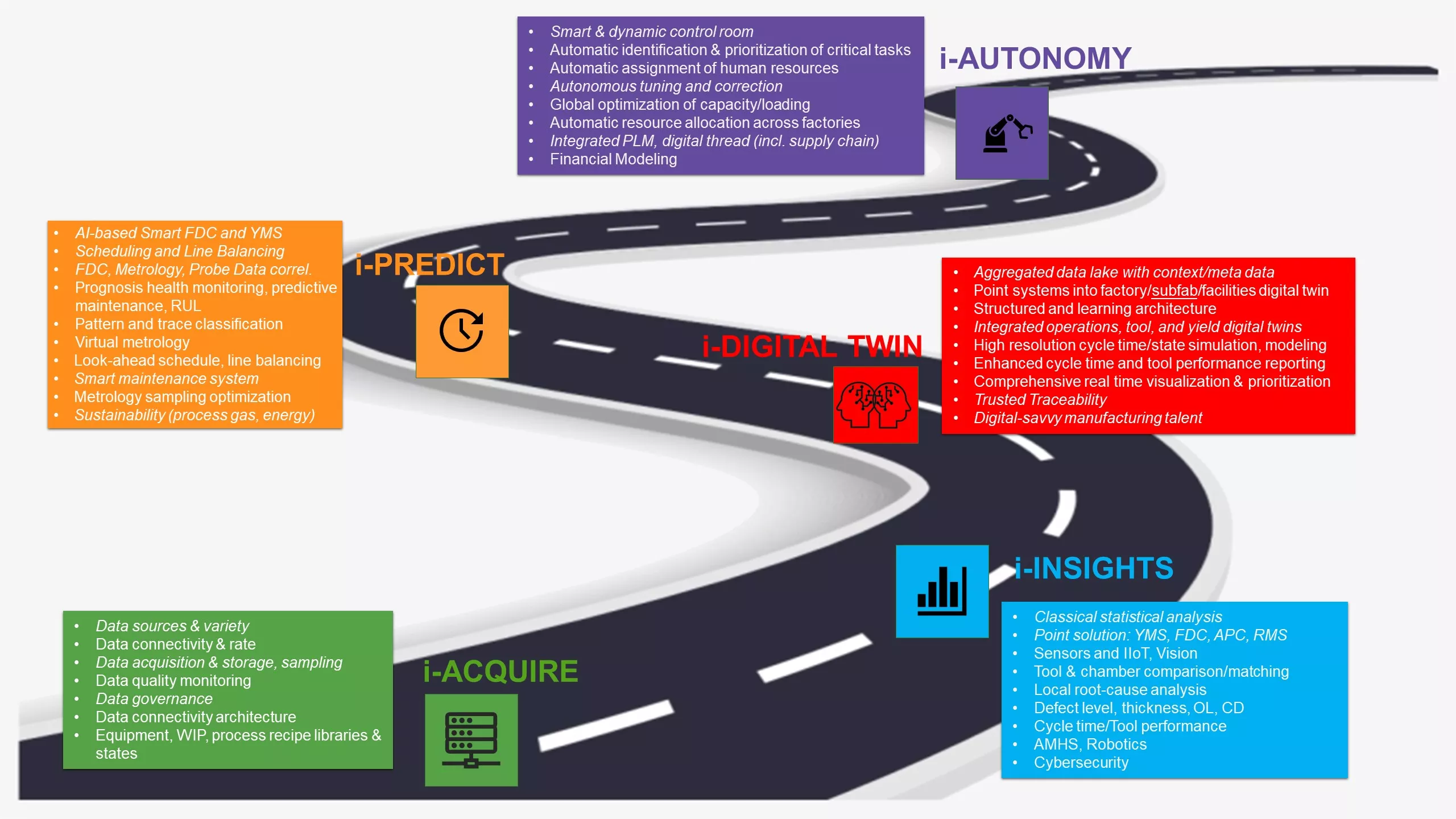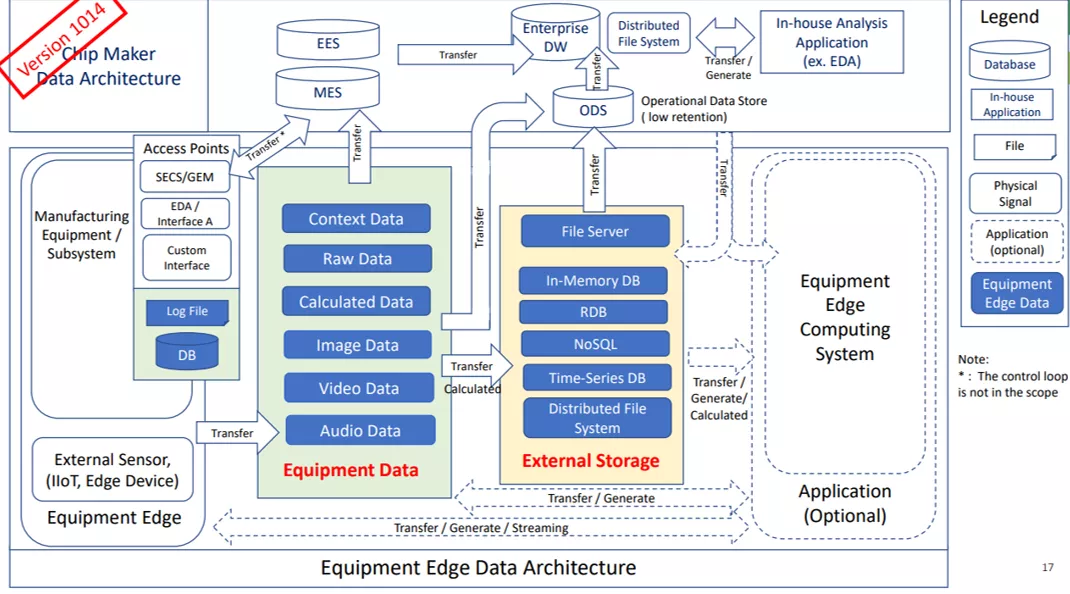
The global semiconductor industry is poised to become a $1 trillion industry by 2030. Semiconductor sales and capital spending are expected to grow substantially in the coming decade with many new wafer fabs (and upgrades) coming online in the next few years. According to the most recent SEMI World Fab Forecast, total 200mm and 300mm wafer fab capacity is expected to grow by over 25% and 50% respectively by 2024. These massive capacity expansions will necessarily integrate advanced Industry 4.0 standards, practices and technology to achieve the highest possible operational efficiency and performance at the start of volume production.
The SEMI Smart Manufacturing Global Executive Committee (GEC) chaired by Dr. Bobby Mitra of Texas Instrruments, comprises key industry leaders across seven global SEMI regions. Over the past year, the GEC has focused on the following areas:
- Industry vision and estimated timeline for cognitive-AI driven autonomous smart factory of the future
- Detailed roadmap, with short-term and long-term priority areas, for autonomous factory based on the following five unique technology stages
- Capability maturity model for assessing progression along sensing, connecting and predicting
Chip manufacturers will build the Cognitive-AI Driven autonomous factory of the future over five technology stages based on an evaluation of their specific manufacturing lines. Figure 1 provides an approximate timeline for implementation of various Smart Manufacturing technology stages by most semiconductor manufacturers.

Figure 1: AI-Driven Smart Factory (Point Systems to Autonomous Solutions) (Courtesy: Inficon)
Figure 2 shows more details including the five key technology stages towards realizing a Smart or autonomous factory. Together, these steps are essential to implementing an Autonomous Factory of the Future encompassing the entire semiconductor product life cycle, from front-end to back-end.

Figure 2: Autonomous Factory of the Future
- i-Acquire – Modern wafer fabs produce an extraordinary amount of data from multiple sources (Figure 3 below) and with unique characteristics – data that is key to building an autonomous factory. Today, this data is mostly fragmented and often exists in disparate locations with limited compatibility in the ways it is communicated, connected and formatted. Data governance, quality, and accuracy are fundamental to efficient manufacturing operations.

Figure 3: Source: SEMI I&C Standards Technical Committee - EEDG (Equipment Edge Data Governance) Task Force Monthly Meeting Report
- i-Insights – Extracting actionable information from data is essential. In most wafer fabs today, combinations of classical analysis, fault detection and classification (FDC), Advanced Process Control (APC), root cause analysis (8Ds), and other established techniques extract deeper insights for tool or chamber matching, better control of a particular process step, determination of a root cause of a process excursion, or improved yield mangement. i-Acquire and the deployment of advanced analysis tools and systems are vital for manufacturing operations teams to gather insights into a particular step or sequence of steps.
- i-Digital Twin – Developing and deploying digital twins[1] are essential for a fully autonomous factory. A digital twin should include detailed, dynamic information (per SEMI standards) on every tool, process and work in progress (WIP) state including product performance. Manufacturing teams must start with individual tools or process sequences before progressing to a digital twin of the entire line in order to provide full visualization and reporting of the integrated operations tools and process flows for a given product. More importantly, other functions such as capacity modeling and scenario what-ifs can be built on top of this platform in order to enable manufacturing operations to dynamically adjust to ever-changing scenarios.
- i-Predict – Once digital twins are available, the next technology step is to deploy artificial intelligence/machine learning (AI/ML) systems and solutions to expand real-time predictive analysis throughout the manufacturing line. All aspects of existing line operations from FDC and metrology, to tool Preventative Maintenance (PM), WIP scheduling, and line balancing could benefit from predictive analysis of product performance and to anticipate potential issues. As process data continues to increase in volume, these systems will continue to learn and further optimize the manufacturing line.
- i-Autonomy – Finally, centralizing operations management in a Smart Control Room is key to automatically tuning tools and processes based on anomalies, dynamically prioritizing tasks, assigning resources, and capturing demand and capacity inputs across the entire factory for multiple products. This fusion and implementation of multiple technologies and domain expertise would mean a paradigm shift in how manufacturing operations perform in the future.
The semiconductor manufacturing industry recognizes the considerable work ahead to make possible the Autonomous Factory of the Future. A key challenge for chipmakers is to assess where their own manufacturing operations are in this journey. The SEMI Smart Manufacturing Initiative Guidelines sub-committee will soon make available an assessment tool that will span the entire product development lifecycle and help manufacturing operations leaders identify critical components required to implement Smart Manufacturing technologies, uncover gaps, and identify areas to target for improvement.

Another Smart Manufacturing Initiative subcommittee focused on fabs is establishing NextGenFDC requirements. Today’s FDC has high rates of false positives and limited integration with metrology and probe data. The goal of NextGenFDC is to implement AI/ML-based anomaly detection and categorization that feeds an expert system to track anomaly categories through class probe for confirmation by part, layer, and technology. This system will help validate or invalidate each FDC anomaly category and would expand to include virtual metrology. The SEMI Smart Manufacturing Initiative Fab sub-committee plans to report out on requirements of NextGenFDC systems.
Finally, the SEMI Smart Manufacturing Initiative helps semiconductor manufacturers and their suppliers improve their processes and optimize the sensing-connecting-predicting chain by overcoming barriers to adoption and speeding the time-to-ROI for smart manufacturing implementations. SEMI Smart Manufacturing activities can help participating companies improve quality management, productivity, and cost-effectiveness by enhancing the capabilities of tools, processes, and people.
Please contact us at us at smartmfg@semi.org if you would like to learn more about the Autonomous Factory Roadmap, and if you’re interested in participating in the Smart Manufacturing Initiative.
Join us for the 2022 Global Smart Manufacturing Conference

The November 8-10 virtual event is returning for the third year with keynotes, tutorials, case studies, and intriguing panel discussions to spotlight the use of data to trim costs, increase yield and improve manufacturing flow. Friendly to time zones in all electronics manufacturing regions, this event is a don’t-miss. Register today!
Learn more by visiting the event website: GSMC 2022—Global Smart Manufacturing Conference | SEMI
[1] A dynamic virtual representation of a physical asset, process, system or environment that behaves identically to its physical counterpart and maybe modified by the real-time process based on accurate configuration of the actual physical equipment
Mark da Silva is Sr. Director of the SEMI Smart Manufacturing Initiative.